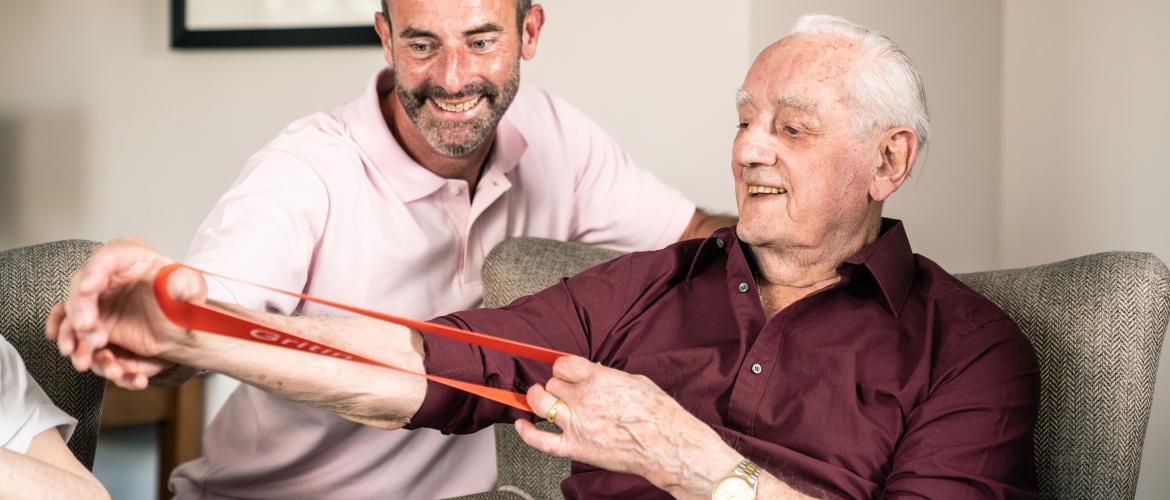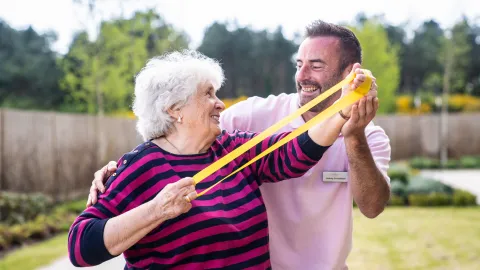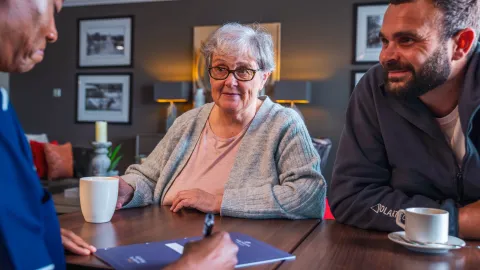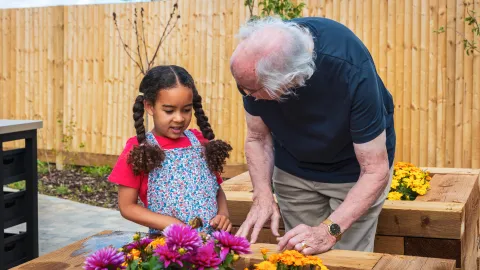
Gentle chair exercises for the elderly
Chair exercises are a great way for the elderly and those with low mobility to stay active. Exercising is important at any age, and chair exercises are an accessible way for older people to stay on top of their exercise routine. It can be those who may not be able to take activities such as walking, cycling or aerobics classes.
The Centre for Disease Control and Prevention (CDC) recommends that people ages 65 and over aim for 150 minutes per week of moderate intensity aerobic activity and 2 days of muscle-strengthening activities. When implementing chair-based exercises into your weekly routine, set realistic goals and work towards them to help you stay on track.
What are the benefits of chair-based exercises?
Chair-based exercises are an excellent and safe way to stay fit and healthy. They offer numerous benefits for your mind, body and soul:
Improved flexibility and easier movement
As you age, your balance or mobility is likely to decline. That’s where chair-based exercises for the elderly come into play – a great way to build strength and improve flexibility without overexerting your body. You build up the ability to cope better with everyday activities, as well as reducing the risk of falls – which is increasingly common in the elderly.
Better heart health without the strain
For better heart health without high blood pressure, your best bet is focusing on low-impact exercises, which makes chair-based exercises a perfect option. Chair-based activities elevate your heart rate and boost circulation, all the while being a lot gentler on your joints, compared to traditional cardio, such as running.
Mood booster and less stress
Not only this, but chair-based activities have significant benefits for your mental state – even just a quick exercise session. Movement increases blood flow to the brain, delivering more oxygen and nutrients to the brain. It can lift your mood, and help reduce anxiety and depression. So why not give it a go?
Recommended seated exercises for the elderly
Make sure you do these exercises at a slow-to-moderate speed. Do carve out time for rest in between each exercise, but keep your feet moving as this helps with circulation. Here are 8 easy and gentle exercises for the elderly:
Simple arm lifts/overhead press
With your arms up, bend, so your wrists are by your shoulders. Slowly punch diagonally up and across your body with one arm. At the same time, slightly rotate your torso in the same direction.
Shoulder circles
A great warm up movement for the shoulders and upper back. Start with your spine straight, your shoulders rolled back and dropped.
Bring your fingertips to lightly touch your shoulders. Whilst doing this, bring your bent elbows in front of the chest and gently bring them together until they touch.
Arms up separating the elbows until they point towards the ceiling, arms close to ears. Bring your elbow in front of your chest, continuing to touch, bringing the shoulders back into internal rotation. Repeat 5-10 times.
Leg lifts/seated march
With your knees bent, lift your leg as much as it is comfortable. Slowly put your foot down. Repeat with the right leg. Do 5–10 lifts with each leg.
Knee extensions
Start with both knees together with your feet on the floor. Straighten one leg out in front of you.
Hold for a second, then slowly re-bend the leg until the foot is resting on the floor again.
Repeat on the other leg. Do a few extensions with each leg.
Seated twists for core
Begin by sitting upright, feet flat on the floor, crossing your arms and reaching for your shoulders.
Turn your upper body to the left, as much as it feels comfortable to do so, avoid moving your hips when doing this.
Hold this position for 5 seconds. Repeat on the right side. Do this five times on each side.
Chest stretches
Start by sitting upright and away from the back of the chair. Pull your shoulders back and down, while extending your arms out to the side.
Then, you want to push your check forward and up until you feel a stretch across your chest. Hold this position for 5 to 10 seconds and repeat five times.
Neck rotations
A good way to improve neck mobility and flexibility. Start by sitting upright with your shoulders down. Keep your gaze straight ahead.
Slowly turn your head towards your left shoulder, as much as it feels comfortable. Hold this position for 5 seconds and return to the starting position.
Repeat on the right. Do three rotations on each side.
Ankle stretches
This exercise helps ankle flexibility and reduces the risk of developing a blood clot. Begin by sitting upright, holding the side of a chair and straightening your left leg with your foot off the floor.
Raise your legs, straight, with your toes pointing away from you
Safety tips and precautions when doing chair exercises
Even though chair-based exercises are low-impact, approach them with some caution. Do make sure you maintain a proper posture by engaging your core with controlled movements and breathing deeply. You also want to make sure you are warming up to prepare your muscles, and cooling down to recover your muscles. Stay hydrated before, while you are exercising and after your session to avoid dehydration.
Stay steady with a sturdy chair
It’s important to look out for certain features when picking out a chair for your exercises. Definitely go for a sturdy, stable chair, especially one without wheels to prevent you from sliding around the floor and causing an injury. A chair without arms is a good idea as it allows you to have a greater range of motion with your arms. If you are stuck, you can find specific chairs designed for seated exercises for elderly people online.
Make sure you have a clutter-free space
Think about the surrounding space. Is it tidy? You want to make sure there isn’t any clutter that will distract you during your workout session or anything that you could potentially knock over. It’s a good idea to have a small section of your room and keep it as your ‘workout space’ to help you stay consistent and motivated. Treat your workout space as you would with any other gym.
Listen to your body and don't overdo it!
Pay attention to how your body responds when you do certain exercises. If you do experience any aches and pains during your chair-based exercises, it’s likely that you are overdoing that particular one or stretching into that exercise more than what you are capable of.
When you are trying out a new type of exercise, it’s important to start slowly and gradually build your way up. That way, you’ll get into a better flow of exercising and be less likely to injure yourself. Avoid holding your breath while exercising. You’ll be surprised how many people tend to do it subconsciously.
Exercise is fun
Exercise should feel enjoyable. And if it doesn’t, there are lots of ways to make it fun. Perhaps you could join forces with a friend for company? Or, you could join group exercise classes, with the opportunity to socialise and meet others there. Opt to take part in exercises that you like doing, so it’s a more pleasant experience for you.
Here at our care homes, we have a range of activities that people can get involved in, whether you want to do it solo or in a group. We have seated exercises for the elderly on offer daily. Rest assured, there’s always something meaningful going on, no matter your mobility levels. See what we have on offer.


